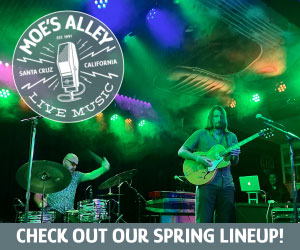Moving my family to Santa Cruz in 1978 was the best decision I ever made. It saved my life from the suburban nightmare of the South Bay. And the lives of my two daughters, ages 8 and 3, who were afforded the opportunity to grow up here. They had lost their mother in a car accident two years prior.
It was a different town then, smaller, more provincial and family-oriented with a conservative pedigree. It was a backwater community based on its location on the far side of the mountains from El Camino Real, the main north-south State Highway 101, which delayed for decades any serious development and exploitation.
I arrived in a white 1967 VW bus and found a ramshackle cottage for rent with ivy tangling through the corner seams below a stand of redwoods located on Walk Circle in the inner lower westside of town. I say “inner” due to the insulation of the “Circles” neighborhood. To this day, you will not see tourists or unfamiliar locals attempting to negotiate the confounding circular streets here. We had our own tiny markets and the smallest library in the world, with fireplace (which still exists today).
I could hardly believe my good fortune, sitting on my front porch at night listening to the seals barking while drawing herbal sustenance from a slow-burning doobie. It was dark enough to see the Milky Way in the southern sky. As far as trouble or theft in the hood, the only item you had to hide was your stash.
Originally developed in the early 20th century as a summer religious retreat, with concentric circles named after church elders surrounding a church in the middle, the Santa Cruz Circles, during the ’60s and ’70s, were pretty much forgotten as a low-rent area to avoid. Our curve on the Circle was inhabited by working class folks—roofer, cable installer, sheet metal fabricator, florist, real estate appraiser—as well as surfers, hippies, students and members of the Friendly Church of Christ and Progressive Baptist Church.
The latter inhabitants were Black folks mostly related to soldiers who had been stationed at Fort Ord during WWII, many originally from Louisiana. These folks consisted of slightly more than 1% of the Santa Cruz population. Their first congregation had been “nudged” from the Eastside by a contingent of concerned white citizens. In the Circles, Mother Brown’s monthly barbecue feast was a favorite treat for neighbors and included her delicious sweet potato pie.
A community organizing group called Westside Neighbors was formed by Mike Rotkin, a lecturer at the 14-year-old University of California campus on the redwood-studded hills above town. The conservative backwater teetered on the precipice of a new, self-described “progressive-feminist” direction. Rotkin would in 1981 become the town’s first progressive mayor.

My daughters, Molly and Vanessa, attended Natural Bridges Elementary School, Mission Hill Junior High and Santa Cruz High School, all within walking or bicycle-riding distance from home. Neither was interested in learning to drive an automobile.
I lived on a shoestring in a town I could not afford to live in if I arrived today. My rent on Walk Circle was $400 a month. I had a back unit that I sub-rented for $100 a month. My landlords, Kurt and Kit Haveman, resourceful scavenger/collector artists, exemplified the counterculture spirit of the times, a period when your plumber might hold a PhD in philosophy.
I found work as editor at Santa Cruz Publishing, owned by publisher Lee May. He and I had both worked at the San Jose Mercury News. Lee provided employment for a crew of talented but troubled characters who needed a sense of direction. He was our father figure. We published several special-interest periodicals. Our ensemble might rightly be found in a Netflix series under the title, The Misbehavin: featuring a cast of addicts, alcoholics and geniuses. Our publications were successful based on the sums (figures not available) they fetched when sold to wannabe publishers who discovered that publishing is not as easy as it looks.
An attractive woman named Barbara lived across the street in a small 60-year-old cottage that she painted blue and dressed with colorful flowers. She and Vanessa became friends and one evening while the sun cast an orangish-yellow hue above our arc of the circle, I asked if she’d like to join me and the girls on a date at the Natural Bridges School Carnival.
She said, “Yes.” We all strolled together to the school where we did the cake walk and won a beautiful confection. Back at my cottage that night we sat at a table and shared the spoils, each receiving a slice of cake with dark chocolate frosting. “Would you like a glass of wine?” I asked Barbara.
She accepted with a comely smile and remarked: “I’ve never had cake and wine together.” Neither had I.
That reference—“cake and wine”—would live on over the years, following our marriage and the birth of our third daughter, Bryna, who was born the day before our annual Walk Circle Fourth of July Block Party, 1982. She also attended the local public school trifecta—Natural Bridges, Mission Hill and Santa Cruz High.
Forty-three years later, Bryna resides within the Hawaiian chain of islands earning a living as an artist with two children, Viva and Mystiko. She recently sold a piece to a Santa Cruz resident whose mailing address is the very same as where Bryna was conceived. Coincidence? Perhaps the cosmic Circle of energy?
To accommodate our growing family, that year we moved into a larger house around the corner on Plateau Avenue. Following the destructive 1989 Loma Prieta Earthquake, we hop-scotched into a small, post-WWII bungalow. By that time Molly and Vanessa had moved out for college and independence. We scored a post-earthquake deal on our house: $300,000 ($760,000 in 2025 dollars) a half block from the water.
Nearly 50 years since I arrived on Walk Circle, Santa Cruz has entered its third or fourth iteration. Housing costs have soared. The new house next door sold for $3.5 million. A cottage in the Circles runs about $1 million. Rents are in the $4,000-and-above range. University students from around the world swarm the sidewalks. The student population has exploded with future plans for more growth. Downtown has morphed into “canyon city,” with high rises popping up like wildflowers in spring. Many houses in our neighborhood are second homes, sitting fallow most of the year.
Yet the greater landscape still exudes the Santa Cruz of yore—beautiful Monterey Bay and much of its sea life, gorgeous mountains beyond town. Newcomers of all stripes express wonder when they arrive, inhale the fresh salty air and hear cries of seagulls in the clear cerulean sky. Take a trip along East Cliff or West Cliff drives, you’re in for a visual treat. But beware of getting caught in the Circles. You may never get out.
Which is a good thing.
Every local has a story to share. If you’d like to tell yours, email br**@we*****.com.














